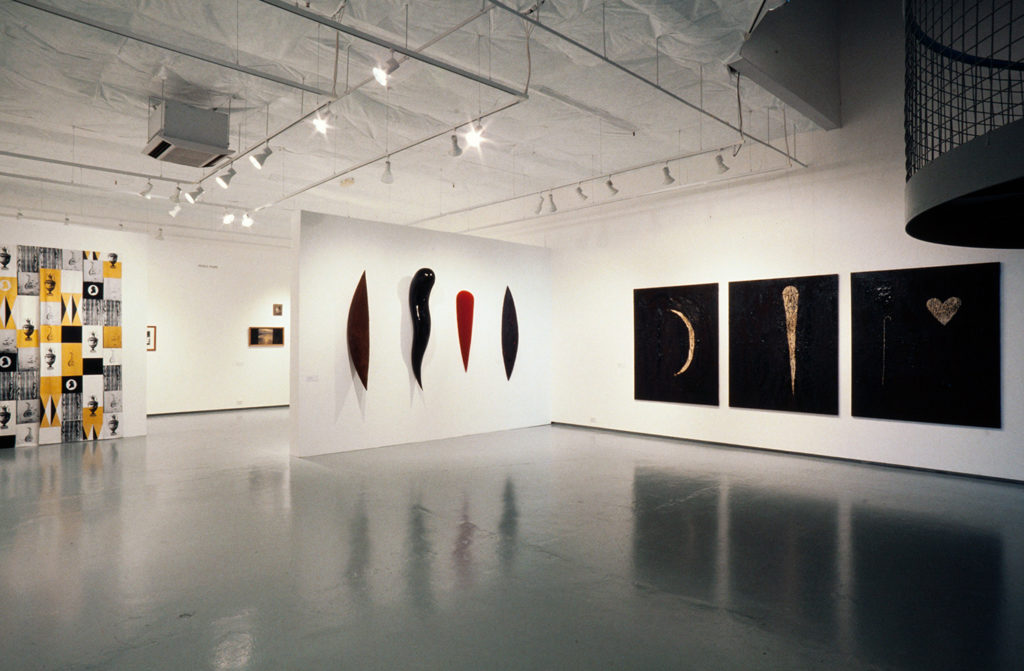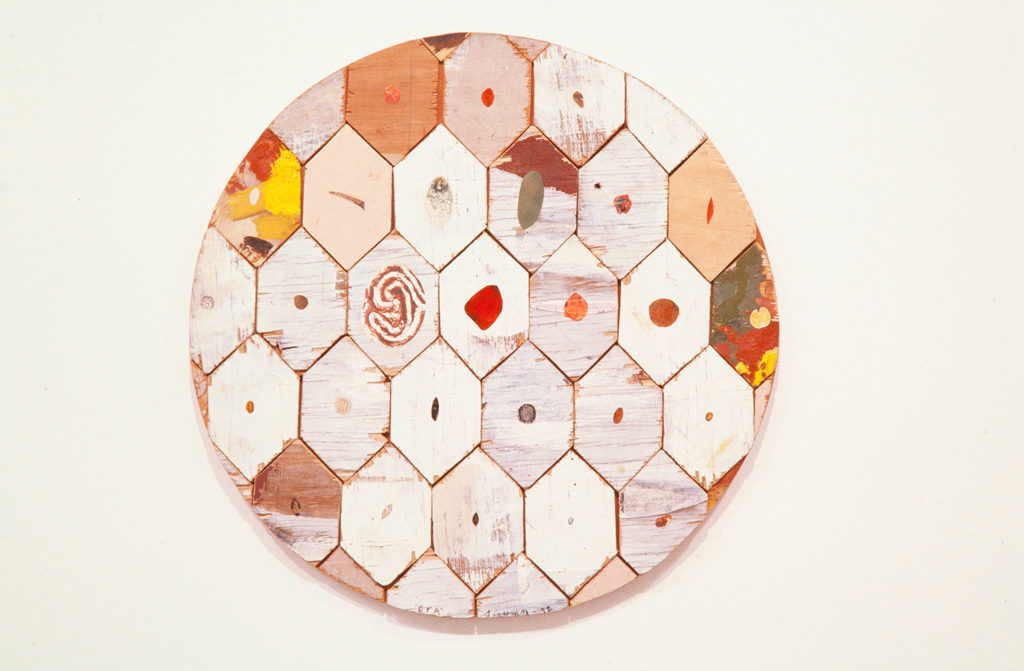ARTISTS Shane Cotton, Luise Fong, Giovanni Intra, Anna Miles, Patrick Pound, Jude Rae, Peter Robinson, Ronnie van Hout CURATORS Gregory Burke, Robert Leonard PARTNER Govett-Brewster Art Gallery, New Plymouth OTHER VENUE Govett-Brewster Art Gallery, 17 October–6 December 1992 PUBLICATION essays Gregory Burke and Robert Leonard, Ben Curnow, Deborah Lawler-Dormer, William McAloon, Stuart McKenzie, Lara Strongman, Bridget Sutherland, Ruth Watson, Stephen Zepke
Shadow of Style fast tracks a new generation of New Zealand artists into public-museum visibility. Wellington City Art Gallery curator Gregory Burke and Govett-Brewster Art Gallery curator Robert Leonard team up to produce this new-artist showcase. In Art New Zealand, Allan Smith describes the show as 'fast, stylish, and elegant, as well as world-weary and melancholic'.
Decorum is a feminine virtue that women artists who want to be taken seriously have often eschewed. Auckland artist Anna Miles embraces it. Her cushions and curtains are screen-printed with signifiers of middle-class taste: including lutes, tea sets, roses, Derby figurines. She presents them as emblems of taste and politeness, all the more refined for not being made to use. Her cushions cannot be sat on, but hang on the wall like paintings; her curtains are not drawn across windows to hide the light, but across gallery walls and spot lit. Miles offers her cushions and curtains as texts to be read. Her curtain, Gentle Reader, is an allegory of reading. In her novels, Jane Austen made asides to her ‘Gentle Reader’, but the polite tone was ironic—a warning bell. For Miles too, gentility is a foil. In Gentle Reader, framed images of brick walls imply the frustrations of reading, while hunting scenes on neckties suggest reading is a quest for a fox that may not be there.
Luise Fong is ambivalent. Her abstract black paintings are stylish and decorative yet conjure up romantic ideas about darkness and the void. Although their forms imply infinite space, this is countered by an emphasis on material and surface (she drills holes in her paintings, and presents one on an easel). Updating feminist 'central core' imagery, the Auckland artist's paintings draw intuitively on her readings of French feminists like Luce Irigaray. She describes her work as 'not opposing binary forces but / something other not understood / but felt within language / within existence'.
For centuries, the depiction of drapery in painting has been a sign of painterly virtuosity. Christchurch painter Jude Rae scrambles this academic tradition with the formats of conceptual art (grids and text). She says her drapery paintings evoke memories: the hem of her mother’s skirt, the sheets of her parent’s bed, veils, dust sheets, funerary shrouds, curtains, bandages, the Virgin’s robes, canvases, and screens. In her paintings, drapery carries a seductive quality, being civilised (covering the body) yet suggestively erotic (mimicking the flesh it conceals). Rae understands her project in the content of recent French feminism. As Julia Kristeva claims: 'a woman is something that cannot be represented, something that is not said, something that is above and beyond nomenclatures and ideologies’.
Melbourne-based expat Patrick Pound describes himself as a tourist of images, travelling through and sampling different image worlds. Images of travel—ocean liners, exotic sights—recur through his work. But, unlike an anthropologist, he seems little concerned to distinguish between the grand and the petty, true and false, high and low, art and non-art. His work Little Deceits: Art Crimes mixes facts (pages from Noble Australians, a who’s who) and fictions (crime novels), collaging portraits and biographies.
Riffing on the Supermarionation aesthetic, Ronnie van Hout's photos of model scenarios cross-reference male fantasies: space exploration, war, sex, national identity. Control and power are implied in images of watchtowers, radars, and missiles. Some of the Christchurch artist's works parody Colin McCahon's landscapes, engaging that cliche of the heroic pioneering male artist discovering himself and his place in one breath. McCahon's presence pervades Van Hout's series Return of the Living Dead, where McCahon's quest is equated with a zombie movie.
Auckland artist Giovanni Intra is interested in subcultural styles—surrealism and punk. His 1990 work Nature Morte shows his early interest in Indian wayside shrines, while anticipating his interest in fetishistic punk gear. Intra focuses on the ways the body's disruption can signal other forms of disorder—psychological and political. His 365 Days and Blood Mobile represent the body in bits, in a state of disarray. Meanwhile, combining conformity and perversion, his Studded Suit is a contradiction in terms—an atypical version of the typical uniform for getting on with business.
Shadow of Style also presents two Māori artists from Christchurch—Shane Cotton and Peter Robinson—just prior to the breakthrough moments that will make their names.
Shane Cotton's paintings fudge the distinction between culture and nature, prompting us to consider his biomorphic imagery in relation to Māori cosmology. Is his painting, Lineage, an image of microbial evolution or of whakapapa? (In 1993, at Wellington's new Hamish McKay Gallery, Cotton will unveil paintings based on early Māori figurative painting that will become the basis of his reputation.)
Peter Robinson paintings and sculptures nod to ancient Māori forms. As primitivist talismans or amulets to ward off disease, they 'hover on the brink of imagined catastrophe—potent projections of change, loss, and decay'. (However, Robinson will soon have an about face, discarding portentousness, to create his brilliant but cynical Percentage and Sold Out works.)
As part of a desire to capture some zeitgeist, the catalogue features writing on the artists by a new generation of writers: Ben Curnow, Deborah Lawler-Dormer, William McAloon, Stuart McKenzie, Lara Strongman, Bridget Sutherland, Ruth Watson, and Stephen Zepke.
The show proves prescient. Six of the eight continue to work as artists, becoming key figures. Giovanni Intra becomes an influential art writer and gallerist in the US, dying young in 2002. (Three of Shadow of Style works enter public collections: Nature Morte, already acquired by the Govett-Brewster, would be followed by 365 Days by Te Papa and the Studded Suit by the Chartwell Collection and Auckland Art Gallery jointly). Anna Miles also becomes an art writer and ultimately a gallerist, directing Auckland's Anna Miles Gallery.
Reviewer Allan Smith writes: 'The tentatively interpretative title and the curators' introductory essay ... encourage the feeling that the show wants to be witness to some "particular moment" as the curators put it ... Perhaps such shows and title can stimulate a certain anxiety—are we fast enough to see the "moment"? Are we as artists or writers part of it? ... The curators' essay refers to the way these eight artists share postmodernist characteristics as elusiveness, irony, loss of oppositional criticality; that for them quotations, appropriation, simulation are givens. It is perhaps the weight of this legacy that accounts for the weariness that pervades the elegance of this exhibition.'




































































































